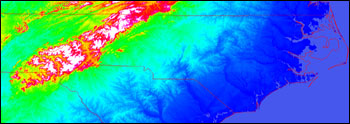

 by David Herring October 2, 2000 | |||
|
River ecosystems are dynamic; they profoundly shape and reshape their environments on an ongoing basis. Pick any river on a map and a biologist can tell you about the myriad plant and animal species that live there. Likewise, a geologist can tell you how the river etched away at its riverbed, continually carrying tiny bits of it downhill and, over millennia, helped carve the surface into the shape it has today. While biologists study how riverine life adapts to the ever-changing chemical and physical state of the ecosystem, geologists examine the processes by which rivers gradually transport vast amounts of minerals and sediment downstream, thereby changing the landscape. A new science discipline emerged recently, and is evolving, that focuses on the "biogeochemical cycles" of rivers and other water bodies. As the term suggests, scientists in this discipline study how changes in the chemical and geological state of a body of water affects plants and animals living there, and how life, in turn, influences the chemical and geological makeup of the ecosystem. "The transport of water and sediment through wetlands and floodplains influences not only the rates and types of biological and chemical processes, but also the geomorphic processes constructing the landforms," explains Leal Mertes. She is an associate professor of geography at the University of California at Santa Barbara and a co-investigator on the NASA-supported Global River Flood Studies team (part of the Earth Observing System program). Mertes helped develop and refine a technique for using satellite remote sensing data to estimate the amount of sediment suspended in surface waters of rivers and wetlands (Mertes et al. 1993; Gomez et al. 1995). Her technique is useful for scientists who want to assess the impacts of increased sediment runoff during a flood event, and how this geochemical change in the water may impact the life forms living there. "Satellites are particularly useful if the river is somewhere geographically inaccessible," Mertes explains. It is not always practical to travel to flood sites wherever and whenever they occur—sometimes in the heart of the Amazon rainforest or other remote regions where it is difficult to transport gear in time to measure the event. Yet on any given day there is a variety of Earth observing satellites that will see every region on the Earth's surface, providing scientists with invaluable data about floods. Mertes and her colleagues within the Dartmouth Flood Observatory (G.R. Brakenridge and E. Anderson) comb news media all over the world and look for reports of floods. When they find one, they begin poring through satellite data archives to find out if any was able to produce images of the event. Then, once they obtain the data, they go to work measuring the extent of the flood, mapping and remapping floodplains (often in places where no maps previously existed or were inaccurate), and measuring sediment concentrations in the water. Mertes and her colleagues were particularly interested in studying the severe flooding in North Carolina brought by Hurricane Floyd in September of 1999. News reports painted a bleak picture of highly-polluted rivers carrying human and animal sewage, topsoil, pesticides and fertilizer, and even animal carcasses in the runoff. Satellite images showed a large plume of sediment spewing out of the rivers and spreading out to sea off the Carolina coast. Consequently, state officials predicted there would be a massive fish kill. |
Hurricane Floyd Series:
This image by the Sea-viewing Wide Field-of-view Sensor (SeaWiFS) provides a clear indication of the power of Hurricane Floyd. The waters along the Florida coast in this September 16, 1999, image appear deep blue except for an irregular narrow band along the coast which is colored yellowish-brown by suspended sediments and dissolved, colored organic materials (CDOM) that wash into the ocean from rivers and are resuspended by the action of the surf and currents in the shallow coastal waters. As Hurricane Floyd passed over these waters, he stirred and mixed them much deeper than normal—deep enough, in this case to resuspend sediments that had settled on the continental shelf nearly 200 meters below the surface. At the shelf edge the water becomes rapidly deeper and bottom sediment could no longer be reached by the hurricane. (Image provided by the SeaWiFS Project, NASA Goddard Space Flight Center, and ORBIMAGE.) click for enlargement |
||

Given the wide extent and the long duration of the floods, Hurricane Floyd gave Mertes a perfect opportunity to test her technique using new data from Landsat 7's Enhanced Thematic Mapper plus (ETM+) sensor, launched just months earlier. How much sediment was flowing through North Carolina's waterways? How extensive were the floods? How accurate were the floodplain maps there? Without even leaving her computer laboratory at UCSB, Mertes would find out. |
This digital elevation model of North Carolina shows the much higher-elevated Appalachian Mountains to the west (white and red pixels), the state's hilly piedmont region in the center (turquoise pixels), and the low-lying, relatively flat coastal plain to the east (dark blue). Notice the complex network of rivers running from the highlands toward the ocean. These waterways were etched into the face of the landscape over geological time by melting glaciers and rainwater runoff. ( Image by Brian Montgomery; data courtesy NIMA) | ||